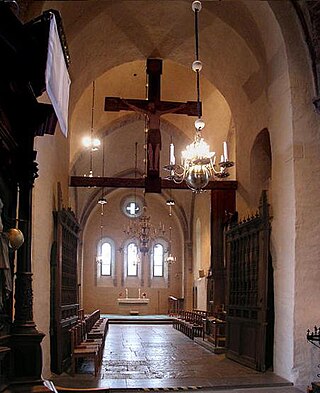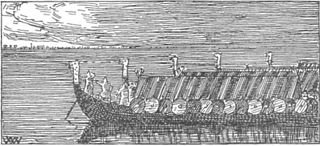Related Research Articles

Year 1042 (MXLII) was a common year starting on Friday of the Julian calendar.

Harold Godwinson, also called Harold II, was the last crowned Anglo-Saxon English king. Harold reigned from 6 January 1066 until his death at the Battle of Hastings, fighting the Norman invaders led by William the Conqueror during the Norman conquest of England. His death marked the end of Anglo-Saxon rule over England.

Harald Sigurdsson, also known as Harald III of Norway and given the epithet Hardrada in the sagas, was King of Norway from 1046 to 1066. Additionally, he unsuccessfully claimed both the Danish throne until 1064 and the English throne in 1066. Before becoming king, Harald had spent around fifteen years in exile as a mercenary and military commander in Kievan Rus' and as a chief of the Varangian Guard in the Byzantine Empire. In his chronicle, Adam of Bremen called him the "Thunderbolt of the North".

Magnus Olafsson, better known as Magnus the Good, was King of Norway from 1035 and King of Denmark from 1042 until his death in 1047.

The Battle of Stamford Bridge took place at the village of Stamford Bridge, East Riding of Yorkshire, in England, on 25 September 1066, between an English army under King Harold Godwinson and an invading Norwegian force led by King Harald Hardrada and the English king's brother Tostig Godwinson. After a bloody battle, both Hardrada and Tostig, along with most of the Norwegians, were killed. Although Harold Godwinson repelled the Norwegian invaders, his army was defeated by the Normans at Hastings less than three weeks later. The battle has traditionally been presented as symbolising the end of the Viking Age, although major Scandinavian campaigns in Britain and Ireland occurred in the following decades, such as those of King Sweyn Estrithson of Denmark in 1069–1070 and King Magnus Barefoot of Norway in 1098 and 1102–1103.

Olaf III or Olaf Haraldsson, known as Olaf the Peaceful, was King of Norway from 1067 until his death in 1093.
Magnus Haraldsson was King of Norway from 1066 to 1069, jointly with his brother Olaf Kyrre from 1067. He was not included in official Norwegian regnal lists until modern times, but has since been counted as Magnus II.

Sweyn Estridsson Ulfsson was King of Denmark from 1047 until his death in 1076. He was the son of Ulf Thorgilsson and Estrid Svendsdatter, and the grandson of Sweyn Forkbeard through his mother's line. He was married three times, and fathered 20 children or more out of wedlock, including the five future kings Harald Hen, Canute the Saint, Oluf Hunger, Eric Evergood, and Niels.

Magnus III Olafsson, better known as Magnus Barefoot, was the King of Norway from 1093 until his death in 1103. His reign was marked by aggressive military campaigns and conquest, particularly in the Norse-dominated parts of the British Isles, where he extended his rule to the Kingdom of the Isles and Dublin.

Stenkil was a King of Sweden who ruled c. 1060 until 1066. He succeeded Emund the Old and became the first king from the House of Stenkil. He is praised as a devout Christian, but with an accommodating stance towards the old Pagan religion. His brief reign saw an armed conflict with Norway.

The Fairhair dynasty was a family of kings founded by Harald I of Norway which united and ruled Norway with few interruptions from the latter half of the 9th century. In the traditional view, this lasted until 1387, however, many modern scholars view this rule as lasting only three generations, ending with Harald Greycloak in the late 10th century. The moniker "Fairhair dynasty" is a retrospective construction: in their lifetime what little traces there are refer to them consistently as "Ynglings".
Ingibiorg Finnsdottir was a daughter of Earl Finn Arnesson and Bergljot Halvdansdottir. She was also a niece of Kings Olaf II and Harald Hardrada of Norway. She is also known as Ingibiorg, the Earls'-Mother. The dates of her life are not known with certainty.

Haralds saga Sigurðarsonar is an Old Icelandic king's saga focusing on the career of King Haraldr Sigurðarson of Norway.
Tora Torbergsdatter was a Norwegian royal consort. She was the mother of two kings of Norway. It is possible, but unconfirmed, that she was also queen of Denmark or Sweden.
The Hardrada dynasty was a powerful royal dynasty which ruled, at various times in history, the Kingdom of Norway, the Kingdom of Mann and the Isles, and the Earldom of Orkney.

The House of Estridsen was a dynasty that provided the kings of Denmark from 1047 to 1412. The dynasty is named after its ancestor Estrid Svendsdatter. The dynasty is sometimes called the Ulfinger, after Estrid's husband, Ulf Jarl. The dynasty also provided three medieval rulers of Sweden and one of Norway. Their family coat of arms became the coat of arms of Denmark and therefore influenced the coat of arms of Tallinn and the coat of arms of Estonia.

The Battle of Niså was a naval battle fought on 9 August 1062 between the forces of Norwegian king Harald Hardrada and king Sweyn II of Denmark. Harald had claimed the Danish throne since 1047, and had launched raids into Denmark ever since. With his invasion in 1062, he wanted to decisively defeat the Danes, and thus finally be able to conquer Denmark. The battle was won clearly by the Norwegians, but since many Danes managed to escape, including Sweyn, it proved indecisive in Harald's attempt to conquer Denmark.
Þjóðólfr Arnórsson was an 11th-century Icelandic skáld, who spent his career as a court poet to the Norwegian kings Magnus the Good and Harald Hardrada and is thought to have died with the latter at the Battle of Stamford Bridge in 1066.
Bergljot Håkonsdatter was a Norwegian noble.
Events from the 11th century in Denmark.
References
- ↑ Krag, Claus. "Magnus 1 Olavsson Den Gode". In Helle, Knut (ed.). Norsk biografisk leksikon (in Norwegian). Oslo: Kunnskapsforlaget. Retrieved 22 July 2015.